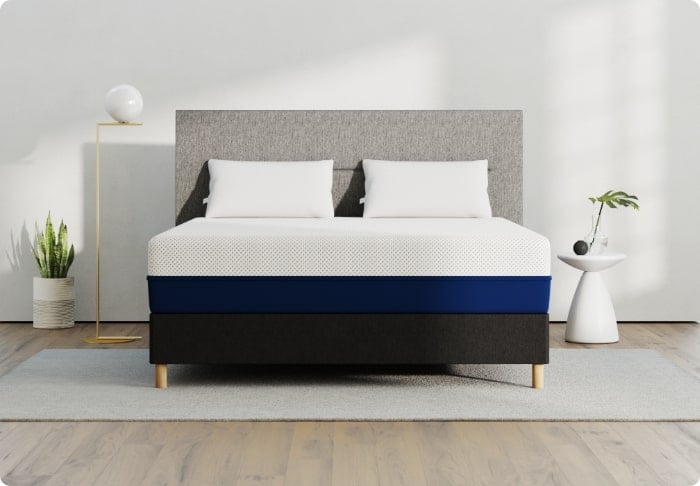Does Freezing Your Sheets and Pillowcase Help You Sleep Cooler?

Key Takeaways
- The cooling effect is extremely short-lived. While frozen sheets do provide immediate cooling relief when you first get into bed, this effect only lasts 5-15 minutes before your body heat warms the fabric back to room temperature, leaving you with the same heat problems you started with.
- The method creates significant practical and health problems. Frozen bedding produces condensation as it thaws, leading to damp, clammy sheets that can promote mold and mildew growth in your mattress. This moisture creates hygiene issues and potential health risks.
- Better alternatives exist for long-term comfort. Instead of this daily hassle, breathable bedding materials like cotton, linen, or bamboo, combined with cooling mattress toppers and proper room temperature control, provide consistent all-night cooling without moisture problems or daily preparation time.
Hot summer nights can turn your bedroom into a sweaty nightmare. You toss and turn, kick off blankets, and still wake up feeling sticky and tired.
Recently, people on social media have started sharing a surprising trick: putting their sheets and pillowcases in the freezer before bed.
This viral hack promises instant relief from overheating while you sleep. Videos show people pulling frozen bedding from their freezers and climbing into bed with satisfied smiles.
But does this chilly solution actually work, or is it just another internet fad? Most importantly, is freezing your bedding safe and practical for regular use?
Read on to discover the science behind this cooling trend, learn whether frozen sheets deliver lasting relief, and find better ways to beat the heat for comfortable sleep all night long.
The Struggle with Hot Summer Nights
Summer heat doesn’t disappear when the sun goes down. Many bedrooms stay warm well into the night, making quality sleep nearly impossible. People wake up drenched in sweat, flip their pillows to find the “cool side,” and kick off covers repeatedly.
Air conditioning bills skyrocket as families try to keep bedrooms comfortable. Some people even sleep on tile floors or take cold showers before bed.
The lack of good sleep affects mood, work performance, and overall health. This nightly battle against heat drives people to try almost anything for relief.
Social Media Hacks for Staying Cool While Sleeping
TikTok and Instagram overflow with cooling hacks that promise better sleep. Users share videos of frozen water bottles placed on pulse points, wet towels draped over fans, and ice packs tucked into pillowcases.
Some people soak their sheets in cold water before bed or freeze their pajamas. Others create DIY air conditioners using buckets of ice and desk fans. A few might even try the unconventional like chilled spoons to certain areas of the body.
These viral videos rack up millions of views as desperate sleepers search for solutions. However, many of these hacks create more problems than they solve, leaving beds damp and uncomfortable.
The Freezing Bedding Trend Explained
The frozen sheets hack involves placing clean bedding in plastic bags and storing them in the freezer for several hours. People typically put their sheets, pillowcases, and sometimes entire comforters into the freezer before bedtime.
The idea seems simple: frozen bedding will cool your body temperature and help you fall asleep faster. Videos show people dramatically pulling icy sheets from freezers and making their beds with theatrical satisfaction.
This trend gained massive popularity during recent heat waves when air conditioning couldn’t keep up. Critics point out serious flaws in this approach, including moisture problems and extremely short-lived cooling effects.
Science of Temperature and Sleep
Your core body temperature drops by about two degrees Fahrenheit as bedtime approaches. This cooling process signals your brain to release melatonin, the hormone that makes you drowsy. Your body temperature reaches its lowest point around 4 AM, then gradually rises toward morning.
Blood vessels in your hands and feet expand during this cooling phase, releasing heat from your core. This temperature drop happens automatically, even in warm environments, though heat can interfere with the process.
Your body works harder to cool down when surrounded by hot air or warm bedding. Disrupting this natural cooling cycle can delay sleep onset by hours.
Why Cooler Temperatures Help You Fall Asleep Faster
Cool environments support your body’s natural temperature drop, making the transition to sleep much smoother. When your surroundings stay cool, your body doesn’t have to work as hard to lower its core temperature. This allows melatonin production to begin on schedule, triggering drowsiness at the right time.
Cool air also prevents sweating, which can wake you up and restart the cooling process. Your nervous system relaxes more easily in cooler conditions, reducing stress and anxiety that keep you awake.
Research shows people fall asleep 36% faster in properly cooled rooms compared to warm ones. The cooling effect signals your brain that it’s time to shut down for the night.
The Ideal Bedroom Temperature for Good Sleep
Sleep experts recommend keeping bedrooms between 60 and 67 degrees Fahrenheit for optimal rest. Most people sleep best when their room temperature stays around 65 degrees throughout the night.
Temperatures above 70 degrees can cause frequent wake-ups and restless sleep. Going below 60 degrees may also disrupt sleep by making your body work to stay warm. Individual preferences vary slightly, but this range works for most adults.
Children and elderly people may need slightly warmer rooms for comfort. However, even small increases above 67 degrees can significantly reduce sleep quality and duration.
What Happens When You Get Too Hot at Night
Overheating during sleep triggers multiple problems that destroy rest quality. Your body starts sweating to cool down, but this moisture makes sheets stick to your skin uncomfortably. Hot conditions prevent the natural temperature drop needed for deep sleep stages.
You spend more time in light sleep and wake up frequently throughout the night. Sweating also leads to dehydration, causing headaches and grogginess the next morning. Your heart rate increases as your body works harder to regulate temperature.
These disruptions can reduce total sleep time by several hours, leaving you exhausted despite spending eight hours in bed.
The Method Explained
People desperate for cooling relief have turned to their freezers as a solution for hot nights. This trend involves multiple approaches, but all center around the idea of pre-chilling bedding before sleep.
How People Are Doing It
The standard method starts with placing clean, dry sheets and pillowcases into large plastic bags or freezer-safe containers. People typically do this 2-4 hours before bedtime to ensure the fabric gets thoroughly cold.
Some users spray their bedding lightly with water before freezing to increase the cooling effect. Once frozen, they quickly remove the bedding and make their bed before the fabric warms up.
The process requires timing since frozen sheets thaw rapidly at room temperature. Most people strip their beds completely and replace everything with the frozen alternatives.
However, the logistics become complicated when dealing with fitted sheets that freeze into rigid shapes.
Different Approaches People Try
Some people freeze only their pillowcases and top sheets, leaving the fitted sheet at room temperature for easier bed-making. Others wrap individual items like blankets or comforters in plastic bags before freezing.
Creative users have tried freezing entire pillow inserts or even mattress toppers when freezer space allows.
Some people use multiple sets of bedding, rotating between frozen and regular sheets throughout extremely hot nights. There’s also the “Egyptian” method of freezing damp towels to place over regular sheets.
Others focus on freezing just the areas that touch their hottest body parts, like where their torso and legs rest. These variations attempt to solve practical problems but often create new complications with moisture and uneven cooling.
The Freezing Socks Hack as an Alternative
The frozen socks method involves placing clean, slightly damp socks for sleep in the freezer and wearing them to bed. This hack targets your feet specifically since cooling your extremities can lower your overall body temperature.
People typically freeze 2-3 pairs of socks so they can change them as each pair thaws and becomes uncomfortable. Some users place the frozen socks inside regular socks to prevent direct contact with extremely cold fabric.
The method appeals to people with limited freezer space who can’t fit entire sheet sets. However, wet socks create obvious problems including soggy bedding and potential skin irritation.
The cooling effect lasts only 10-20 minutes before the socks warm up and become clammy.
Time Frames and Preparation Needed
Most bedding requires 3-4 hours of freezing time to reach optimal coldness, though thinner materials like cotton sheets freeze faster than thick comforters.
The preparation process demands significant planning since you must start the freezing process well before feeling sleepy.
Frozen sheets typically provide noticeable cooling for only 5-15 minutes after removal from the freezer. Thicker items like blankets may stay cool for up to 30 minutes but also take longer to freeze completely.
Users must work quickly during the bed-making process since exposure to room air rapidly warms the fabric. The entire routine requires clearing substantial freezer space, which means removing food or other items.
Many people find the daily preparation too time-consuming and impractical for regular use.
Does It Actually Work?
The frozen bedding method does provide immediate cooling, but its effectiveness depends on realistic expectations. Most users discover significant limitations that make this hack less impressive than social media suggests.
See, it’s more about immediate cooling than lasting coolness. Frozen sheets create an instant cold sensation when you first get into bed, providing quick relief during hot nights.
The cooling effect disappears within 5-15 minutes as your body heat quickly warms the fabric back to room temperature.
Online reviews show mixed results, with many people finding the brief cooling benefit doesn’t outweigh the hassle and discomfort.
From a scientific perspective, while brief cooling can help trigger drowsiness, it doesn’t provide the sustained temperature control needed for quality sleep throughout the night.
The frozen bedding hack offers a quick cooling burst that fades fast, leaving you with the same temperature challenges you started with. While it might provide temporary relief during extreme heat, the method creates more inconvenience than lasting comfort for most people.
Critical Points
The frozen bedding trend comes with serious drawbacks that most social media posts don’t mention. These problems often make the cooling benefits not worth the hassle and potential health risks.
- Potential problems with moisture and condensation – Frozen fabric creates water droplets as it warms up, soaking your mattress and creating dampness throughout your bed.
- Risk of mold or mildew from damp bedding – Wet bedding becomes a breeding ground for harmful fungi within 24-48 hours, especially dangerous for people with allergies or breathing problems.
- Uncomfortable dampness when sheets thaw – As bedding thaws, it becomes clammy and sticky, trapping heat against your body and making you feel hotter than before.
- Time and effort required each night – The method demands 3-4 hours of planning, clearing freezer space, and careful preparation that becomes exhausting after just a few nights.
- Not practical for everyday use – Limited freezer space, backup bedding needs, and daily complications make this hack impossible to sustain as a regular cooling solution.
Many people discover these practical problems outweigh any temporary cooling relief the method provides. The frozen bedding hack creates more sleep disruption than comfort for anyone trying to use it regularly.
Safety and Health Concerns
Freezing bedding creates several health risks that can be more dangerous than dealing with hot nights. These safety issues affect different people in various ways, making this cooling method potentially harmful for many users.
Skin Sensitivity to Extreme Cold
Direct contact with frozen fabric can cause frostbite-like injuries, especially on sensitive areas like your face, neck, and limbs. People with diabetes or circulation problems face higher risks of cold-related skin damage that may not heal properly.
The extreme temperature shock can trigger painful reactions in people with conditions like Raynaud’s disease or cold urticaria. Children and elderly individuals have thinner skin that suffers cold damage more easily than healthy adult skin.
Even brief exposure to frozen bedding can cause numbness, tingling, or burning sensations that last for hours.
Risk of Catching a Cold from Damp Bedding
Sleeping in damp, cold conditions weakens your immune system and makes you more susceptible to respiratory infections. The combination of moisture and temperature changes creates stress on your body that reduces its ability to fight off viruses and bacteria.
Damp bedding keeps your body temperature lower than normal throughout the night, which can trigger cold and flu symptoms. People who already have weakened immune systems face even greater risks of developing serious respiratory illnesses.
The moisture also creates breeding grounds for harmful microorganisms that can cause skin infections and other health problems.
Hygiene Considerations
Frozen bedding that thaws becomes a perfect environment for bacteria, fungi, and dust mites to multiply rapidly. The condensation and moisture make it difficult to keep bedding truly clean, even with frequent washing.
Damp fabric holds onto body oils, sweat, and dead skin cells more effectively than dry bedding, creating unpleasant odors and hygiene issues. People with sensitive skin or allergies may experience rashes, itching, or other reactions from sleeping on contaminated damp bedding.
The moisture can also transfer bacteria from your skin to your pillows and mattress, creating long-term cleanliness problems.
When This Method Might Be Harmful
People with heart conditions should avoid frozen bedding because the temperature shock can trigger dangerous changes in heart rate and blood pressure.
Pregnant women face increased risks since extreme temperature changes can affect blood flow and cause discomfort that disrupts necessary rest.
Children under 12 have less developed temperature regulation systems and should never sleep with frozen bedding due to hypothermia risks.
Anyone taking medications that affect circulation or temperature regulation should consult a doctor before trying this cooling method.
People recovering from illness or surgery need stable sleep environments and should avoid any methods that create additional physical stress.
FAQs
How long do I need to freeze my sheets to get the cooling effect?
Most bedding requires 3-4 hours in the freezer to reach optimal coldness, though thin cotton sheets may freeze faster than thick comforters. The freezing time depends on your freezer temperature, the thickness of your bedding, and whether you place items in plastic bags.
You should start the freezing process well before you plan to go to bed since the preparation takes significant time. Keep in mind that the cooling effect only lasts 5-15 minutes once you get into bed, so timing becomes crucial for this method to work.
Is it safe to sleep with frozen bedding every night?
Daily use of frozen bedding isn’t recommended due to moisture problems, potential skin irritation, and health risks from damp sleeping conditions. The condensation from thawing sheets can create mold and mildew in your mattress, which poses serious health hazards over time.
People with circulation problems, heart conditions, or sensitive skin should avoid this method entirely due to risks from extreme cold exposure. It’s safer to use frozen bedding only as an occasional emergency cooling solution during extreme heat waves.
Will frozen socks really help me sleep cooler?
Frozen socks can provide temporary cooling since your feet play a key role in regulating body temperature, but the effect is very brief. The cooling sensation typically lasts only 10-20 minutes before the socks warm up and become uncomfortably damp against your skin.
Wet socks can make your bedding soggy and create conditions for bacterial growth, which may cause skin irritation or infections. This method works better as a quick cool-down technique before sleep rather than something you wear throughout the night.
What’s the best alternative to freezing bedding for staying cool?
Breathable bedding materials like cotton, linen, or bamboo provide consistent cooling throughout the night without any daily preparation or moisture problems. These natural fabrics allow air to flow through the fibers and wick moisture away from your skin, keeping you comfortable for hours.
Cooling mattress toppers with gel or phase-change materials offer targeted temperature regulation exactly where your body needs it most. Combining breathable bedding with proper room temperature control and air circulation creates the most effective cooling system for quality sleep.
How much does it cost to switch to cooling bedding alternatives?
Basic cotton or bamboo sheet sets offer excellent breathability and moisture-wicking properties that work consistently throughout the night. Cooling mattress toppers with gel or phase-change materials provide targeted temperature regulation and last for several years with proper care.
Fans for air circulation and programmable thermostats can significantly improve your sleep environment while potentially reducing energy consumption over time. While these alternatives require an initial investment, they eliminate daily preparation time and provide much better long-term comfort compared to frozen bedding methods.
Can frozen bedding damage my mattress or pillows?
Yes, the condensation from frozen bedding can cause serious damage to your mattress and pillows over time. The moisture soaks into mattress materials and creates perfect conditions for mold, mildew, and bacteria growth that can permanently damage expensive bedding.
Once mold establishes itself in your mattress, it becomes extremely difficult and costly to remove completely. The dampness can also cause staining, odors, and structural damage that may void your mattress warranty.
What should I do during a heat wave if I don’t have air conditioning?
Focus on pre-cooling your bedroom by running fans, opening windows during cooler evening hours, and taking a cool shower before bed. Use lightweight, breathable sleepwear and consider placing a damp towel on your forehead or wrists to cool pulse points safely.
Strategic fan placement can create cross-breezes, and placing a bowl of ice near a fan creates a DIY cooling effect for your room. If you must try frozen bedding during extreme heat, use it only occasionally and ensure you have backup dry bedding available when the frozen sheets become uncomfortably damp.
Conclusion
The frozen bedding trend shows how desperate people feel when dealing with hot summer nights, and the initial cooling effect can provide genuine relief. However, this method works best as an occasional emergency solution rather than a nightly routine due to its brief duration and practical challenges.
The moisture issues and daily preparation time make it less convenient than it appears in viral videos, though some people may find it helpful during extreme heat waves. For consistent, comfortable sleep, proven alternatives like breathable bedding materials and cooling mattress toppers offer better long-term value and effectiveness.
These established methods provide all-night comfort without requiring daily freezer space or creating dampness concerns. When choosing cooling solutions, consider your specific needs, budget, and how much daily effort you’re willing to invest.
The best cooling method is one that works reliably for your situation and helps you wake up refreshed every morning.



